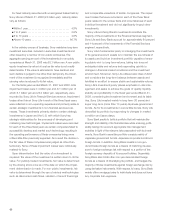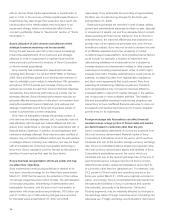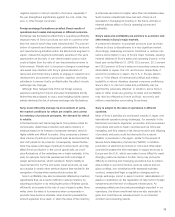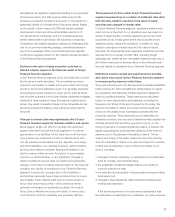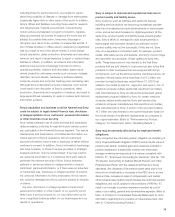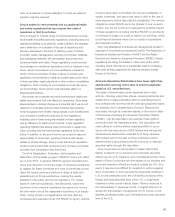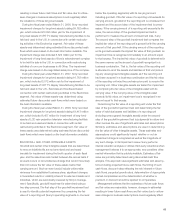Sony 2008 Annual Report Download - page 78
Download and view the complete annual report
Please find page 78 of the 2008 Sony annual report below. You can navigate through the pages in the report by either clicking on the pages listed below, or by using the keyword search tool below to find specific information within the annual report.76
The large-scale investment required during the development
and introductory period of a new gaming platform may not
be fully recovered.
Within the Game segment, developing and providing products
that maintain competitiveness over an extended life-cycle
requires large-scale investment relating to research and develop-
ment, particularly during the development and introductory
period of a new platform. In the past, large-scale investment
relating to capital expenditures and research and development
for the manufacture of key components, including semiconduc-
tors supplied for PS3, was also recorded within the Electronics
segment. Moreover, it is particularly important in the Game
segment that these products are provided to consumers at
competitive prices to ensure the favorable market penetration of
the platform. Should the platform fail to achieve such favorable
market penetration, there is a risk that this investment, or a part
thereof, will not be recouped, resulting in a significant negative
impact on Sony’s profitability. In addition, even if Sony is able to
sufficiently recoup its investment, significant negative impact on
Sony’s operating results could occur during the introductory
period of the platform. Further, even if the platform is ultimately
successful, it may take longer than expected to recoup the
investment, resulting in a negative impact on Sony’s profitability.
An example of such a significant negative impact during the
introductory period of a platform are PS3-related charges that
resulted in losses of 232.3 billion yen and 124.5 billion yen within
the Game segment for the fiscal years ended March 31, 2007
and 2008, respectively. These losses arose from the strategic
pricing of PS3 hardware at points lower than its production cost.
(Refer to “Electronics” section of “Trend Information” and “Game”
section of “Operating Performance by Business Segment” at
“Operating Results.”)
Sony’s Game and Electronics segments are particularly
sensitive to year-end holiday season demand.
Since the Game segment offers a relatively small range of
hardware products (including PS2, PSP® and PS3) and a
significant portion of overall demand is weighted towards the
year-end holiday season, factors such as changes in the
competitive environment, changes in market conditions,
delays in the release of highly anticipated software titles and
insufficient supply of hardware during the year-end holiday
season can negatively impact the financial performance of
both the Game and the Electronics segments. The Electronics
segment is also dependent upon year-end holiday season
demand and, to a lesser extent than the Game segment, is
susceptible to weak sales as well as supply shortages that
may prevent it from meeting demand for its products during
this season.
The sales and profitability of Sony’s Game segment
depends on the penetration of its gaming platforms,
which is sensitive to software line-ups, including software
produced by third parties.
In the Game segment, the penetration of gaming platforms is a
significant factor driving sales and profitability, which may be
affected by the ability to provide customers with sufficient
software line-ups, including software produced by third parties.
Software line-ups affect not only software sales and profitability,
as in many other content businesses, but also affect the
penetration of gaming platforms, which can affect hardware
sales and profitability.
Operating results for Sony’s Pictures segment vary according
to the cost of productions, customer acceptance, timing of
releases or syndication sales, and competing products.
Operating results for the Pictures segment’s motion picture
and television productions can materially fluctuate depending
primarily upon the cost of such productions and acceptance
of such productions by the public, both of which are difficult
to predict, as well as the timing of new motion picture
releases and the syndication of television productions. In
addition, the commercial success of the Pictures segment’s
motion picture and television productions depends upon the
public’s acceptance of other competing productions, and the
availability of alternative forms of entertainment and leisure
activities.
Sony’s Pictures segment is subject to labor interruption.
The Pictures segment is dependent upon highly specialized
union members who are essential to the production of motion
pictures and television programs. A strike by one or more of
these unions could delay or halt production activities. Such a
delay or halt, depending on the length of time involved, could
cause delay or interruption in the release of new motion pictures
and television programs and thereby could adversely affect
revenues and cash flows in the Pictures segment.
Sony’s Financial Services segment operates in highly
regulated industries and new rules, regulations and
regulatory initiatives by government authorities could
adversely affect the flexibility of its business operation.
Sony’s Financial Services segment operates in industries subject
to comprehensive regulation and supervision, including the
Japanese insurance and banking industries. Future develop-
ments or changes in laws, regulations or policies and their
effects are unpredictable and could lead to increased compli-
ance expenses or limitations on operations. For example,
Japan’s Financial Services Agency (“FSA”) has recently


